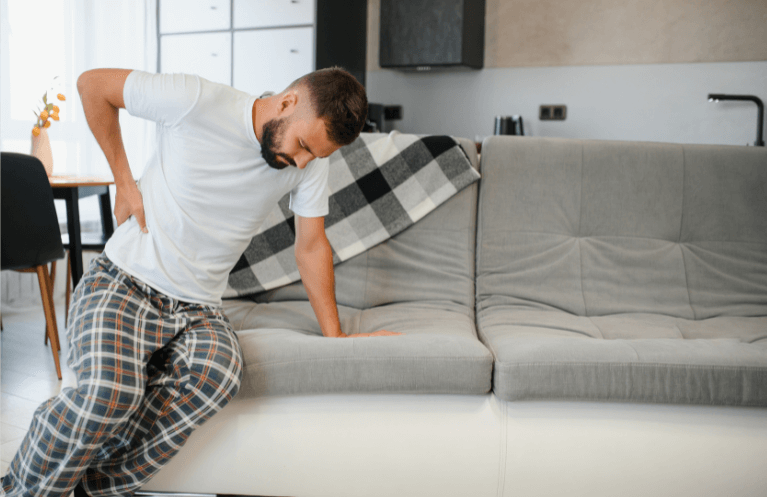There are many reasons why one may develop back or neck pain. Back and neck pain may range from mild to severe, and you may experience accompanying symptoms.
Neck pain is most commonly caused by muscle strains, which can develop due to a cervical herniated disc, cervical degenerative disc disease, or cervical osteoarthritis. Anything that causes the spine’s anatomy to change can result in back pain, such as lumbar disc herniation, lumbar degenerative disc disease, sacroiliac joint dysfunction, or osteoarthritis!
Luckily, physical therapy can help relieve back and neck pain and help you get back to living your everyday, pain-free life. If you’re searching for pain relief from a chronic back or neck pain condition, give us a call today to schedule an appointment. We will help ease your symptoms and teach you how to manage your pain without using harmful medications.
Common causes of back pain
You don’t have to be lifting something heavy to sustain a back injury. Several factors can contribute to back pain.
The source of the pain comes from injury or irritation of the muscles, joints (including the intervertebral discs and facet joints), nerves or surrounding ligaments, and other soft tissue.
Some of the contributing factors are often associated with back pain are:
- Improper posture or prolonged positions (i.e., prolonged sitting)
- Spinal muscle and tissue damage (i.e., lifting strains or trauma from accidents)
- Limited hip, spine, and pelvis mobility
- Limited muscle flexibility
- Spinal/pelvic muscle weaknesses (aka “core” weakness)
- Poor abdominal, pelvic and back muscle coordination (i.e., compensations due to injury)
Unfortunately, a lot of people don’t seek treatment when back pain arises. They might assume nothing—except for medication and rest—can solve their back pain problem, and this simply is not the case!
Common causes of neck pain
Neck pain is most commonly caused by an injury to the tissues or bone structures in the neck; however, certain degenerative conditions can also lead to neck pain.
Some common conditions that give you a pain in your neck include:
- Muscle strains –The muscles in your neck can become strained by overuse. Even something as simple as sitting at your desk all day with your neck craned toward the computer screen can lead to a strain on your neck muscles.
- Illnesses – Certain diseases and ailments can result in neck pain, such as rheumatoid arthritis and meningitis.
- Nerve compression – If you have a herniated disc in your neck or narrowing of the foramen (space where the nerves exit the spine), the nerves that branch out from your spinal cord can become compressed. In some cases, nerve pain can even extend from the neck all the way down to the hands and fingers — a condition known as “radiculopathy.”
- Injuries – Whiplash is one of the most common injuries that result in neck pain, typically sustained by an automobile or high-impact sports collision. This is known as a “strain” injury, causing the head to whip back and forth rapidly, thus affecting the soft tissues in the back of the neck.
What should I do if I have back or neck pains?
If you’re experiencing back or neck pain, it is important to consult with your primary doctor right away. He or she will most likely perform a physical exam and may want to take some x-rays or a magnetic resonance imaging (MRI) test.
With an MRI, your doctor will be able to see your soft tissues, ligaments, tendons, and blood vessels, which can provide evidence of where your back or neck pain is stemming from. Once this is determined, your doctor will suggest a course of treatment, which will likely include physical therapy.
Back pain and neck pain can lead to a loss of productivity, and it is a common cause of disability. Because of this, it is important to seek the assistance of a medical professional immediately if you are suffering from back or neck pain.
How will physical therapy help my back or neck pain?
Physical therapy is an effective treatment for both back and neck pain. The goals and expected outcomes of these treatments include:
- Decreased pain and stiffness. By using passive treatments such as manual therapy, your physical therapist will help alleviate pain in the affected area and accelerate the healing process.
- Prevention of further issues. By learning proper body mechanics, you can avoid future injuries and prevent pain from recurring.
- Increased range of motion. Your physical therapist will implement flexibility exercises into your treatment plan, which will help increase the range of motion in your back and neck.
- Improved strength. Your physical therapist will create a specific exercise plan for your particular needs, which will aid in the strengthening of muscles in the affected area.
- Improved quality of life. Physical therapy can help you return to your normal routine much quicker, allowing for an overall improvement in quality of life.
Treatment plans are comprised of both passive and active methods. Passive treatments work to relieve pain, inflammation, and stiffness, while active treatments work to improve strength, flexibility, and function.
Common passive treatments include ice and heat therapies, manual therapy, electrical stimulation, and ultrasound. Active treatments include targeted stretches and exercises that your physical therapist will prescribe.
Contact us today for relief!
Are you living with back or neck pain? If so, say goodbye today with the help of physical therapy. Contact us today to confirm your appointment and get started on the first steps toward pain relief.
Sources:
- https://www.moveforwardpt.com/SymptomsConditionsDetail.aspx?cid=8402b1d2-6580-41b2-b4ff-25a0cd6dac3a
- https://www.moveforwardpt.com/SymptomsConditionsDetail.aspx?cid=d0456c65-7906-4453-b334-d9780612bdd3
Tags: back pain, Natural treatment, pain relief, neck pain, back and neck pain, houghton physical therapy



